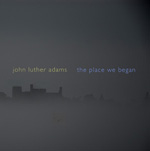|
|
 |
Dusted Reviews
Artist: John Luther Adams Album: The Place We Began Label: Cold Blue Review date: May. 8, 2009 |

|
|
|
 |
Alaska-based composer John Luther Adams’ powerful music finds inspiration, depth of field, and sonic substance in the shapes and textures of the natural world and, most of all, in the composer’s own deep and passionate commitment to the act of listening itself.
Adams made the four pieces on The Place We Began from fragments of his own 1970s work recently rediscovered in a box of reel-to-reel tapes. The album is book-ended by two re-workings of an earlier project exploring the interactions of electro-acoustic feedback and the resonant frequencies of room sound. The first of these, “in a room,” rises spectrally, its long, ringing and droning tones arcing skyward over chthonic low-frequency rumbles The closing piece, “the place we began,” utilizes the same source material to trace a downward arc, the falling, slowing tones now revealing lusciously tactile and hypnotic pulses of harmonic and timbral motion and interaction.
Between these works, at the heart of the CD, are two pieces that make use of traditional instruments, albeit in imaginative ways. “at the still point” is mysteriously beautiful, with what seem to be pitch, speed and envelope manipulations applied to the hushed, bell-like tones of Fender Rhodes electric piano. Beyond its textural allure, the piece also creates interest via subtle gamelan-like structures and staggered relationships between its layers: bell-like mensurations eventually standing out against the low- and mid-frequency tonal washes; fragmented clusters of electric piano arriving to form vaguely impressionistic harmonic events that hint, perhaps, in a dreamlike way, at 1970s Joe Zawinul.
“in the rain” is even more distinctly layered, its strata including field-recorded nature sounds, an organic gamelan (this time created by the sound of rain falling into metal pots), and further spectral manipulations applied to clusters of acoustic piano. Resonant and evocative, this work goes deep, seeming to touch upon personal memory and the eternal shapes and patterns of nature.
Depth of field and resonant, sensory evocation have not been unusual in Adams’ body of work. The Place We Began offers further evidence of the composer’s command and confidence, his fertile imagination and assured technique. And while Adams doesn’t necessarily sound like precursors Cage, Feldman and Oliveros, he does share with those American masters a definite commitment to the creation of unique and engaging music that springs from an experienced intensity of absolute listening.
By Kevin Macneil Brown
|







